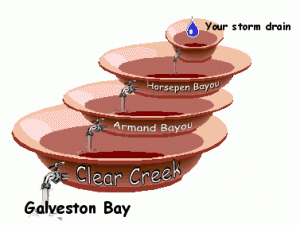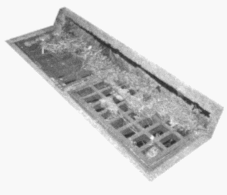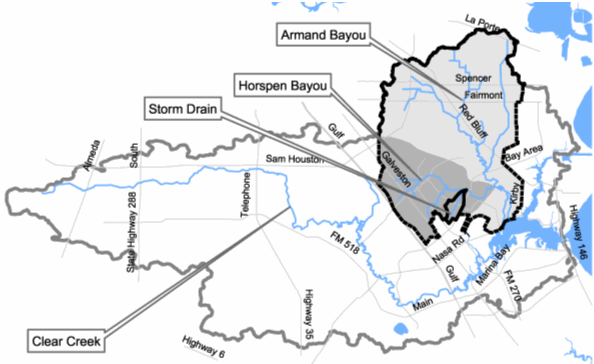Selected Lower Galveston Bay Watersheds
- Armand Bayou Watershed
- Clear Creek Watershed
- Dickinson Bayou Watershed
- Highland Bayou Watershed
What is a Watershed and Why Should You Care?
You live in a watershed! It doesn’t matter where you live – in the city, in the country, on a mountaintop, or in a swamp – you live in a watershed. Because water drains from wherever you are to a river, a bayou, a lake, or a bay. And what you do where you live has a direct impact on the rivers or the bays that you drain to. That’s why you should care and why you should know what a watershed is!
 A watershed is simply the area of land that drains to a common outlet (usually a stream or river). The watershed is usually named for the river that drains it. For example, the Colorado River watershed is drained by the Colorado River. Watersheds can be large (like the Colorado) or small (like Horsepen Bayou, below), and smaller watersheds exist within larger watersheds. You likely live in more than one watershed. The figure to the right shows a series of watersheds in suburban Houston. It shows how each watershed is like a bowl with an outlet. (click image to enlarge)
A watershed is simply the area of land that drains to a common outlet (usually a stream or river). The watershed is usually named for the river that drains it. For example, the Colorado River watershed is drained by the Colorado River. Watersheds can be large (like the Colorado) or small (like Horsepen Bayou, below), and smaller watersheds exist within larger watersheds. You likely live in more than one watershed. The figure to the right shows a series of watersheds in suburban Houston. It shows how each watershed is like a bowl with an outlet. (click image to enlarge)
The map above shows the same watersheds, but on a real map, with streets, streams, and bays.
Stormwater runoff is the most common way that water gets from where you are down to the stream or bayou that drains your watershed. If you live out in the country, you can easily follow the path water follows—perhaps through a few ditches until it reaches the first creek.
 But if you live in the city, where water goes may not be quite so obvious. A storm drain, like the one on the left, might be the last place you see stormwater after it leaves your house. And what do you think happens to the stormwater once it enters this drain? Maybe it gets cleaned up in a treatment plant? Not at all! Once down the storm drain, stormwater goes through a series of pipes and perhaps ditches right into the river or creek, just like it does in the country. And whatever you put into that storm drain, either directly or through what you put on your lawn or throw on the ground, goes right into the river or bay.
But if you live in the city, where water goes may not be quite so obvious. A storm drain, like the one on the left, might be the last place you see stormwater after it leaves your house. And what do you think happens to the stormwater once it enters this drain? Maybe it gets cleaned up in a treatment plant? Not at all! Once down the storm drain, stormwater goes through a series of pipes and perhaps ditches right into the river or creek, just like it does in the country. And whatever you put into that storm drain, either directly or through what you put on your lawn or throw on the ground, goes right into the river or bay.
What can you do? Don’t Pollute!
– Use Watersmart landscaping methods
– Never pour oil or any other contaminant down the storm drain
– Keep trash off the streets—don’t litter!
Find out what watershed you live in!
You know your street address, right? Your “earth address” is your watershed. Know what it is! Its just as important, if not more important, than your street address is.
The Environmental Protection Agency maintains a “Surf Your Watershed” web site. You can input your zipcode or the name of your city or town to find out what watershed you live in.
Look at any map of your area. What are the names of the closest streams to your house? Chances are, you live in the watershed of those streams. The National Map will show most of the waterbodies in your area. For really good detail, look at the 1:24:000 topographic maps produced by the United States Geological Survey. Information about where to get these maps can be found at USGS Topo Maps webpage.
Get Involved!
Join or form a watershed association. Many citizen groups are forming around the country to help restore or clean up their watershed. Contact your local county agent or check with the Texas Commission on Environmental Quality about watershed groups that might exist in your area.
 Texas Community Watershed Partners
Texas Community Watershed Partners 
